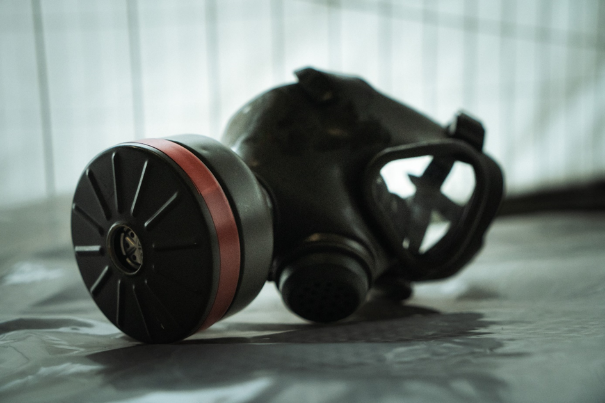Medical CBRN Training at EUMAM UKRAINE

|
A cordoned-off barracks area somewhere in the south of Germany. It is still quiet in the tent where a small group of Ukrainian soldiers have gathered. Until recently, many of them were civilians and employed as doctors or technical personnel in hospitals in Ukraine. And now they are in the EU where they are to be trained as specialists who are needed more urgently than ever in the face of war. In the future, their task will be to take care of patients who have been exposed to biological, chemical, radiological or nuclear hazards. Suddenly, it all goes very quickly: A soldier has come into contact with a chemical agent and is unconscious. The first aider, too, gets seriously injured when trying to get him out of the danger area. The group splits up immediately and begins administering first aid to both casualties. First, they perform what is called a triage, which allows to classify patients according to the severity of their injuries and plan further treatment. The group stays focused and works together to stop life-threatening bleeding first. They do this by using a tourniquet – a binding system that can be used to interrupt the blood flow in the veins and arteries of the affected extremities. At the same time, it is vital to look at the symptoms or use test systems to find out as quickly as possible which agent the patients have come into contact with. Because only if the appropriate antidote is administered in due time can the patient's life be saved. These first aid measures still take place at the casualty collection point before the patients are eventually brought to the decontamination tent for further treatment and decontamination.
Perfect Teamwork Inside the tent, the phase of emergency medical treatment and decontamination finally begins, following the cAaBCDE scheme.
-------------------------------------------------------------------------------------------------------------------------------------------------------- Infobox Critical bleeding: Critical bleeding has priority and, if possible, is treated using a tourniquet. Airway management: Check airways, address/touch the patient and check the mouth of an unconscious patient for foreign bodies. antidotes (emergency): In case of nerve agent or blood agent poisoning, life-saving antidotes must be given very early in the treatment process. Breathing: Check for breathing, check chest area and back for any further injuries. Circulation: Check circulation/pulse and look for wounds by systematically palpating along the entire body. A pulse oximeter helps to identify the heart rate and oxygen saturation level. Disability: Pupillary reaction and information on the state of consciousness. Environment: Protect the patient from adverse weather effects and prepare them for evacuation whilst focusing on keeping them warm. --------------------------------------------------------------------------------------------------------------------------------------------------------
During this phase, speed and precision work are crucial because all steps must be completed before the MedEvac (medical evacuation) personnel arrives, and without losing sight of the patient's condition. The team leader immediately starts to coordinate the tasks and both teams quickly begin to provide care to their patient. Although all training participants are experienced medical personnel, the protective equipment they wear to protect themselves from contamination turns even routine movements into challenges. Upon completion of each step, the soldiers must decontaminate their hands and the equipment used to prevent further spread of the toxic substance. But the greasy decontaminant makes the handling of medical equipment even more difficult and it keeps falling onto the ground, in which case it must not, under any circumstances, be used again. While the patients are still receiving medical treatment, two training participants begin to cut off and remove the patients’ contaminated clothes. Yet before the patients are transferred to the “clean” area and prepared for evacuation, everything that is to leave the contaminated area must be decontaminated again. This does not only include the patients and medical personnel but also any items such as respirators or patient documentation, which contains all necessary information on the injuries incurred by and the treatment provided to the patient and will be handed over to MedEvac personnel. Military MedEvac forms part of the rescue chain and refers to the evacuation or movement of injured persons whilst providing qualified medical treatment comparable to that of a civilian ambulance.
End of Exercise Under the watchful eyes of the EUMAM UA instructors, the patients are handed over to MedEvac personnel – but a surprise still awaits the participants: The patients’ clothes had been covered with a fluorescent, which becomes visible when placed under black light. The instructors are now able to assess in detail how far the contamination has spread. Over the next hours and days, the participants are repeatedly confronted with new scenarios focusing mainly on the handling of chemical agents. Moreover, they learn more details on the properties, symptoms and treatment methods of different substances in short class lessons between the scenarios. It is during these training phases, in particular, that the linguists employed to support the training make a substantial contribution by translating the complex topics and technical terms in a comprehensive manner. Everybody involved in the training is aware that anything that is just an exercise right now may quickly turn into an emergency back in Ukraine. “The Ukrainian soldiers are highly motivated and eager to learn. They want to do the training wearing their full protective equipment as they have realised that, in an emergency, they must be able to carry out medical measures in those clothes”, the chief instructor says and praises them for their talent to improvise. This training module is a pilot project for the instructors, too. Although similar courses for specialised forces have existed for a long time in EU Member States, training periods are usually considerably longer. These participants, by comparison, will be needed back at their workplaces in Ukrainian hospitals, to take care of soldiers wounded in the war, after only seven days of training. |








